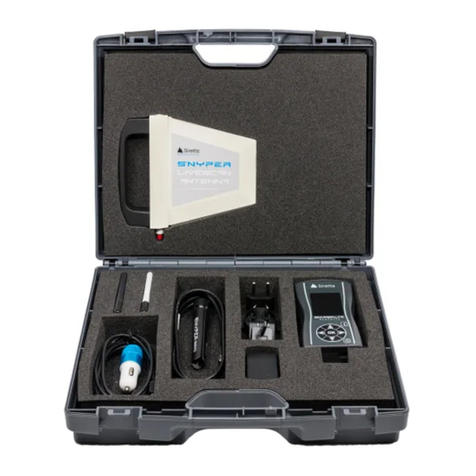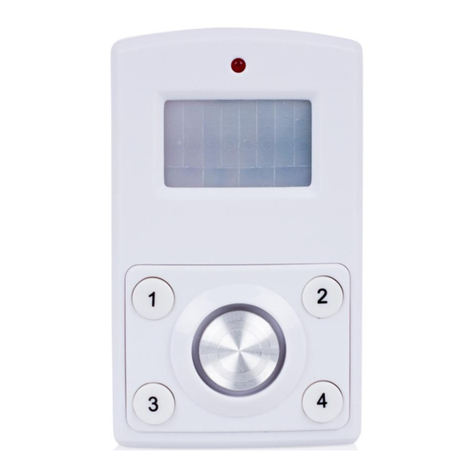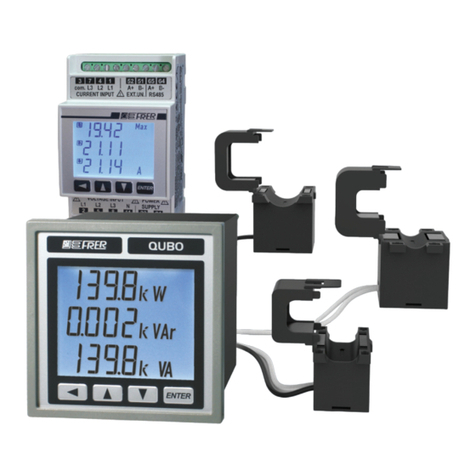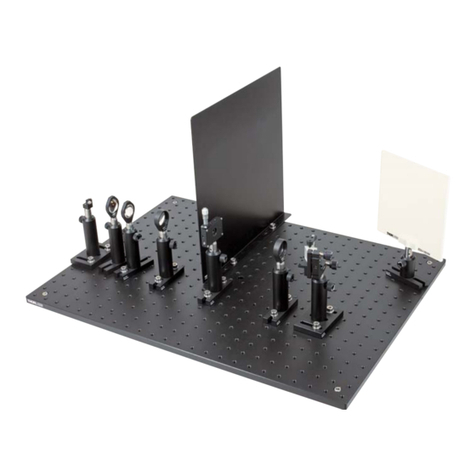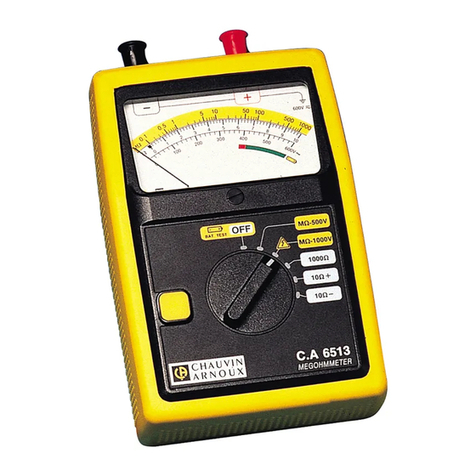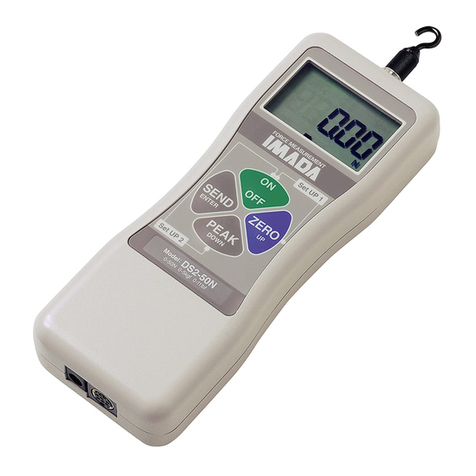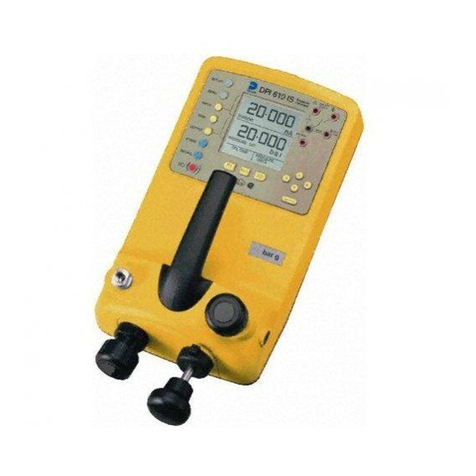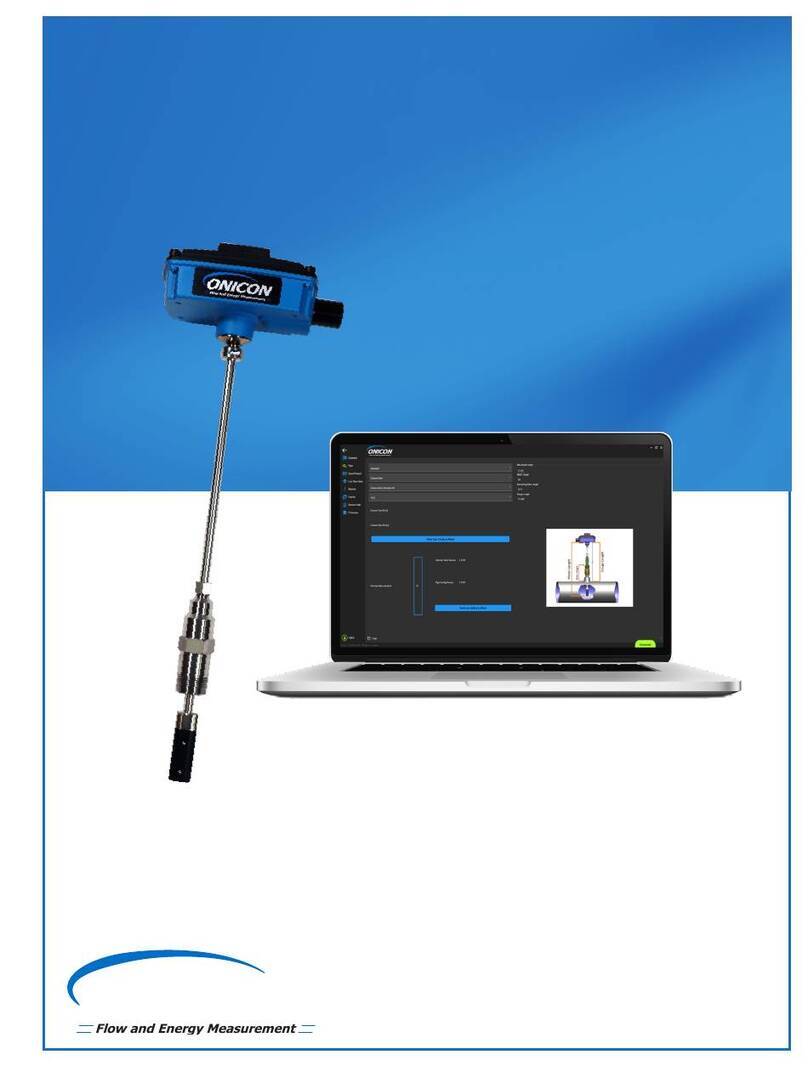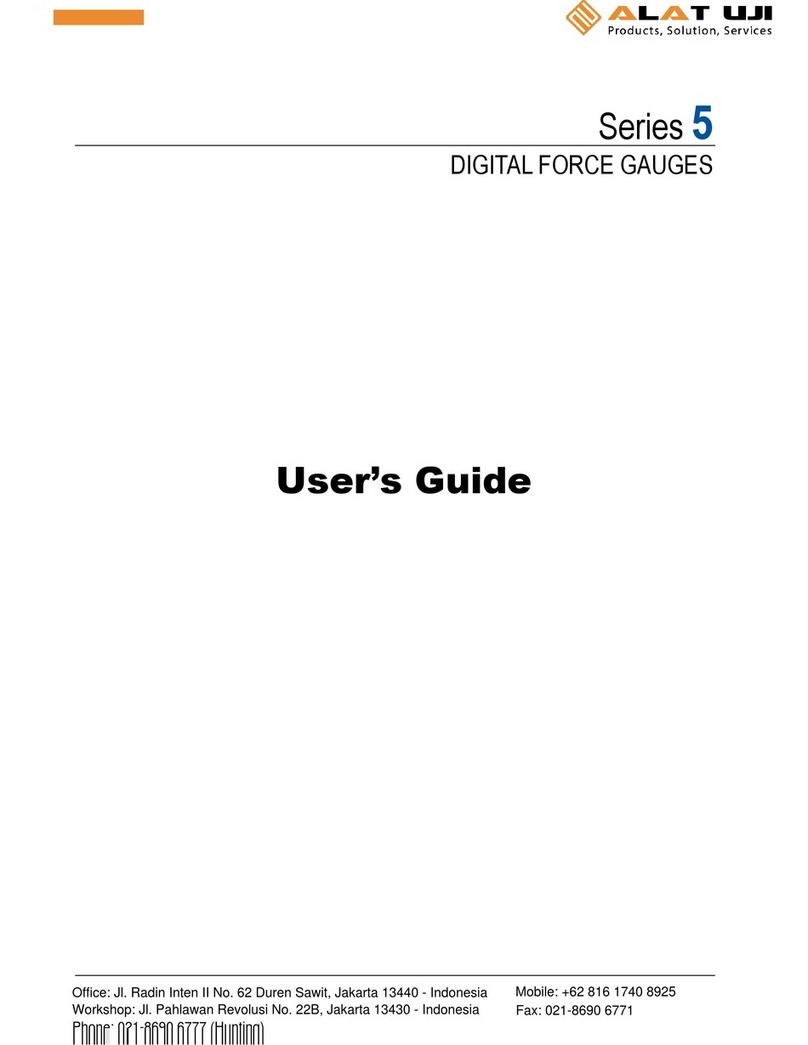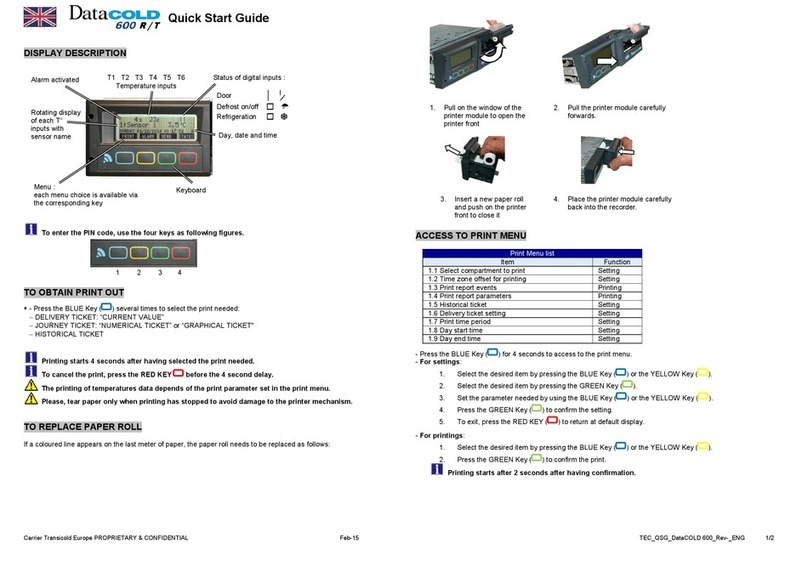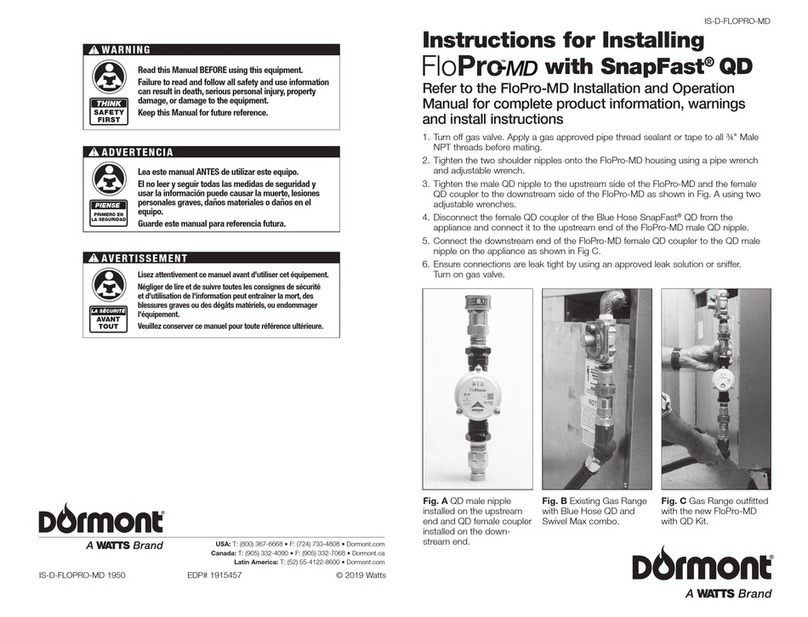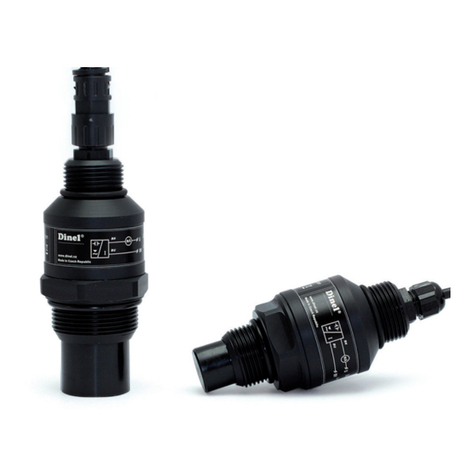Setra Systems 370 User manual

Operator's Manual
Model 370
Digital Pressure Gauge


INTRODUCTION
About t is Manual....................................................................................... iii
SECTION ONE
Installing t e Model 370 ..............................................................................1
SECTION TWO: SUMMARY OF FUNCTIONS
2.1 Keyboard Functions ............................................................................3
2.2 Display Symbol....................................................................................4
2.3 Display Messages ...............................................................................5
SECTION THREE: DIGITAL PRESSUREGAUGE FUNCTIONS
3.1 Entering a Number or Function ...........................................................7
3.2 Clearing a Number or Function ...........................................................7
3.3 If You Make a Mistake.........................................................................7
3.4 Converting Engineering Units..............................................................8
3.5 Tracking Min and Max Values .............................................................8
3.6 Setting and C ecking Alarm Setpoints................................................9
3.7 Tares and Offsets..............................................................................10
3.8 Printing Out Information ....................................................................11
3.9 Repetitive Printing .............................................................................12
3.10 Printing Setup Status.........................................................................13
3.11 Interfacing wit a Computer ..............................................................13
SECTION FOUR: ADVANCED PRESSUREGAUGE FUNCTIONS.
4.1 User Defined Engineering Units ........................................................15
4.2 Digital Altimeter Setting Indicator (DASI) ..........................................17
SECTION FIVE: DISPLAYING ALTITUDE
5.1 Standard Altitude Conversions..........................................................19
5.2 True Corrected Altitude .....................................................................20
5.3 Relative Altitude ................................................................................22
Table of Contents
i

Appendix I: SETUP FUNCTIONS
I.1 Formatting Baud Rate .......................................................................23
I.2 Disabling Beeper...............................................................................24
I.3 Programmable Stability Indicator ......................................................24
I.4 Omitting Engineering Units................................................................25
I.5 Software Revision Number................................................................25
I.6 Self Diagnostics.................................................................................26
Appendix II: CALIBRATION
II.1 Zero Calibration.................................................................................27
II.2 Span Calibration................................................................................28
Appendix III: RS-232 SERIAL DATA COMMUNICATIONS
III.1 Interfacing Setra 370 to a Computer .................................................29
III.2 Sending Commands to t e 370.........................................................30
III.3 Receiving Data from t e 370.............................................................31
III.4 Immediate and Repetitive Print Modes .............................................32
III.5 Verify Function ..................................................................................32
III.6 Status After Power is Applied............................................................32
III.7 RS-232 Interface Hardware...............................................................33
Appendix IV: ACCESSORIES AND OPTIONS
IV.1 Battery Powered Operation ...............................................................35
IV.2 In Case of Difficulty ...........................................................................36
IV.3 Options ..............................................................................................36
IV.4 Specifications ....................................................................................37
Appendix V: WARRANTY INFORMATION
V.1 Limited Warranty - Pressure Products ..............................................39
Appendices
ii

Introduction
Congratulations, and t ank you for purc asing a SETRA Model 370 ig accu-
racy Digital PressureGauge. Its ease of operation and durable construction will
provide years of reliable service. W ile t egauge is easy to operate, it is advis-
able to read t is guide carefully before use. It is designed to elp you take full
advantage of t e functions and performance of t e gauge.
T is guide is divided into five major sections:
Section One explains installation and power requirements for t e Model 370.
Section Two provides a summary of t e various keys, functions, displays and
messages you will encounter w en using t is pressure gauge.
Section T ree explains in detail t e basic functions and uses of t is gauge in
pressure measurement.
Section Four describes some advanced pressure measurement features avail-
able in t e Model 370.
Section Five provides detailed instructions for t e correct measurement of
altitude for Model 370's wit absolute or barometric pressure sensors.
T e Appendices include calibration and setup information, and instructions for
interfacing t e gauge wit computers and ot er equipment. Also provided are
specifications, lists of accessories, and a warranty statement.
iii

iv
OUTLINE DRAWING
Rear View
oo
AC Power
Pressure Port
RS-232 I/O On/Off
(Battery Only)
ide View
8.55
217
5.5
140
6.0
152
7.2
183
7.5
191
8.55
217

ection One
IN TALLING THE MODEL 370
T e Setra Digital PressureGauge, Model 370, is a ig ly accurate pressure meas-
urement system utilizing t e patented SETRACERAM sensor, advanced micro-
computer based electronics, and sop isticated firmware, resulting in a 0.02% FS
system accuracy.
T e unusual ergonomic design of t e Model 370 allows it to be used as a benc top
instrument (wit keypad and display at t e proper angle for viewing), as a portable
device wit a built in carry andle, or as a rack mount instrument wit t e optional
19" rack mount kit.
ETUP
Connect t e pressure gauge to an AC outlet by inserting one end of t e provided
power cord into t e back of t e gauge, and t e ot er end of t e cord to t e AC outlet.
T e gauge will operate at any voltage from 100 to 240 VAC, 50 or 60 Hz. Once you
ave plugged your gauge into a live outlet, it is automatically on.
T e gauge uses very little power, and may be left connected permanently.
If you ave t e optional battery, refer to Appendix IV concerning battery power and
automatic rec arging.
DI PLAY TE T
W en your gauge is first powered on, it automatically performs a display test, s ow-
ing all possible display segments. T is test lasts approximately six seconds. T e
gauge next displays "HELLO" and performs self-diagnostics to ensure proper
operation. T e gauge t en counts down to zero, and is ready for use.
PRE URE CONNECTION
T e Model 370 provides a standard 1/8" NPT female pipe t read pressure port wit
filter, for connection to a variety of available fittings. T e pressure gauge is rated for
clean dry gas (nonconductive/noncorrosive).
T e Proof Pressure of t e Model 370 (t e maximum pressure w ic can be applied
wit out disturbing t e calibration of t e gauge) is 150% of t e full scale pressure. To
ensure t at t e pressure applied to t e gauge does not exceed t e proof pressure,
properly rated relief valves s ould be installed in any system t is gauge is connected
to.
T at's all t ere is to installation. It is important t at you read t is User's Guide
t oroug ly to ensure proper use of t e gauge. T e summary of Functions in t e next
Section serves as a andy reference.
1

7 8 9
4 5 6
1 2 3
0-.
min
max
f(p)
set
points
set up zero
print span
conv clear
EA
LEVEL HI LO ALARM
O.K.
units ft
mmbar
in hg
H2O P I
-888888
Digital Pressure Gage
Display
6 digit LCD wit Annunciators for
Alarms, Min/Max values and
Engineering Units.
span
Use wit SetUp
Key for Full Scale
Calibration.
clear
Exits Programming Mode To
Normal Operation.
O.K.
User Program-
mable Indication
of Pressure Signal
Stability.
set up
Program Custom
Functions and
Perform
Recalibration.
print
Sends Display Data T roug a
Bidirectional RS-232 I/O Port. Program-
mable for Continous or Interval Printing,
300-9600 Baud Rate.
conv
Automatic Engineering Units
Conversion for Pressure and
Altitude. Predefined Units are
Pa, PSI, mbar, mmHg, inHg,
mmH2O, inH2O, ft, m, units.
set points
Hi/Lo Alarms-User Defined.
Alarm Indications are
Display Flas ing, Audible
Tone and Message Sent
Out I/O Port.
f(p)
Programmable Non-
Linear Function Key for
Barometric Ranges.
Converts True Baromet-
ric Pressure To Sea
Level Pressure.
min/max
Tracks Minimum and Maximum
Values Encountered.
zero
Dual Function Key
Operates as Tare or
wit SetUp key as
Zero Calibration.
Keypad
Numeric keypad for
Entry of Custom
Conversion Factors,
Setpoints and
Calibration Data.
2
Portability and Accuracy
Right Where You Need It

ection Two
UMMARY OF FUNCTION
2.1 KEYBOARD FUNCTION
Send information to a printer or ot er perip eral.
Convert engineering units being displayed.
Display HI and Lo Alarm setpoints.
Enter relative or absolute tare value.
Display minimum and maximum value encountered.
Clear t e number or key sequence being entered or displayed.
Convert true pressure to SEA-LEVEL pressure (absolute pressure).
Send status summary to a printer or ot er perip eral.
C ange Hi and Lo Alarm setpoints.
Enter MIN/MAX tracking mode.
Exit MIN/MAX tracking mode.
Perform ZERO calibration procedure.
Perform SPAN calibration procedure.
Clear t e display, turn off MIN/MAX, clear t e tare value, convert
to display t e units t e gauge was calibrated in.
clear
f(p)
set
points
clear
setup print
min
max
setup
setup
3
set
points
setup
zero
min
max
conv
print
min
max
setup zero
span

2.2 DI PLAY YMBOL
OK
T e readings are wit in t e user defined stability requirement.
hPa
T e reading s own is given in ectopascals.
P I
T e reading s own is given in pounds per square inc .
inHg
T e reading s own is given in inc es of mercury.
mbar
T e reading s own is given in millibars.
mmHg
T e reading s own is given in millimeters of mercury.
inH2O
T e reading s own is given in inc es of water.
mmH2O
T e reading s own is given in millimeters of water.
ft
T e reading s own is given in feet of altitude.
m
T e reading s own is given in meters of altitude.
EALEVEL
T e reading s own is corrected to sea level.
units
T e reading s own is given in user-defined pressure units.
HI ALARM
T e reading s own exceeds t e HI setpoint.
LO ALARM
T e reading s own exceeds t e LO setpoint.
HI
T e reading s own is t e maximum value encountered.
LO
T e reading s own is t e minimum value encountered.
4

2.3 DI PLAY ME AGE
UnAbLE
T e gauge is unable to execute t e requested function in its
current configuration. Clear t e display and continue.
OFLO
T e display is over-ranged because excess pressure is applied
or because t e user-defined conversion exceeds t e number of
digits available in t e display.
FLA HING
DI PLAY
T e pressure applied exceeds t e rated range of t e sensor.
BU Y
T e gauge is acquiring a stable reading.
Ot er messages w ic are displayed in t e course of using t e various functions of
t e Model 370 are explained in t e sections of t e manual concerning t ose functions.
5

6

ection Three
DIGITAL PRE URE GAUGE FUNCTION
3.1 ENTERING A NUMBER OR FUNCTION
To enter a number or function, simply press t e key or keys w ic
correspond to t e numbers or functions you wis to enter.
3.2 CLEARING A NUMBER OR FUNCTION
To clear a function or number you ave begun to enter, press t e CLEAR
key. T is automatically returns t e gauge to display mode, wit out affecting
any ot er functions w ic may be in use.
To reset t e Model 370 to its power up condition, press "-", t en CLEAR.
T is clears t e zero/tare value, s uts off MIN/MAX, and converts back to
t e original engineering units. All of t ese functions are described in later
sections of t is guide.
3.3 IF YOU MAKE A MI TAKE
If you mis-enter a number or enter a number or function t e gauge cannot
accept, t e display will read "UnAbLE". Press CLEAR to resume normal
display, and re-enter t e number or function.
7

3.4 CONVERTING ENGINEERING UNIT
T e Model 370 will measure pressure in any engineering units, including six
built-in pressure conversions, two built-in altitude conversions, and a
user definable conversion.
To convert from one unit to anot er, simply press t e CONV key repeatedly
until t e units you want are in t e display. T e order of units is as follows:
Pa - PSI - mbar - mmHg - inHg - mmH2O - inH2O - ft - m - units. To return
directly to t e units t e gauge was calibrated in, press "-" t en CONV.
See Section 4.1 for instructions on t e use of user-defined units ("units"),
or Section 5 for displaying altitude.
3.5 TRACKING MIN AND MAX VALUE
To use t e Model 370 to track t e minimum and maximum pressures applied to
t e sensor, enter t e tracking mode by pressing ETUP, t en MIN/MAX.
To examine t e values stored, press MIN/MAX. T e gauge will display "HI"
and t e maximum value encountered for about t ree seconds, t en will
display "LO" and t e minimum value encountered for about t ree seconds,
and t en will revert to normal display.
To s ut off t e min/max tracking mode, press "-", t en MIN/MAX.
If t e MIN/MAX key is pressed wit out aving first entered t e MIN/MAX
tracking mode as described above, t e display will read "UnAbLE". Press
CLEAR and t en follow t e above procedure.
8

3.6 ETTING AND U ING ALARM ETPOINT
T e Model 370 as an alarm capability w ic will indicate w en t e pressure
applied as exceeded a ig or a low setpoint. T e annunciators are an
audible tone, a display message of "HI ALARM", and a message sent
t roug t e communications port.
To examine t e current value of t e setpoints, press ETPOINT . T e
gauge will display "HI ALARM" and t e ig setpoint for about t ree
seconds, t en will display "LO ALARM" and t e low setpoint for about
t ree seconds, and t en will revert to normal display.
To enter new setpoints, convert to t e engineering units you wis to use,
and decide w at values you will enter in t e following procedure. Entering
a value w ic is too ig or too low will cause t e display to read "UnAbLE".
If t is appens, press CLEAR to resume normal display mode.
1. Press ETUP, t en ETPOINT . T e display will s ow "HI
ALARM" and t e current ig setpoint.
2. Now you can enter a new ig setpoint by entering a number. To
keep t e current setpoint wit out c anging it, proceed to t e next
step wit out entering a new number.
3. Press ETUP. T e Model 370 will accept t e number in t e display
as t e ig setpoint, and immediately s ow "LO ALARM" and t e
low setpoint.
4. Enter a new low setpoint, or to keep t e current low setpoint, proceed
to t e next step wit out entering a number.
5. Press ETUP. T e number in t e display will be accepted as t e
low setpoint, and t e gauge will revert to its normal display.
T e factory setting for t e ig setpoint is 105% of t e pressure range,
and t e low setpoint is 5% below t e pressure range. To effectively disable
t e alarm setpoints, reset t em to t ese values using t e above procedure for
entering setpoints.
9

3.7 U ING THE TARE AND ZERO FUNCTION
T e TARE function on t e Model 370 gives you a way of setting t e
displayed reading to zero or of subtracting a specified offset so t at you
can monitor c anges in pressure relative to a known starting point. T is is
done by creating a tare value w ic will be subtracted before eac up-
dated reading is displayed.
To set t e display to zero, press ZERO. T e gauge will save t e reading in
t e display as t e tare value, and will subtract t at value from every sub-
sequent reading before displaying it.
To subtract an offset from t e display, enter t e amount of t e offset and
press ZERO.
To add an offset to t e display, press "-", t en enter t e amount of t e
offset and press ZERO.
To restore t e normal display, press "-", t en press ZERO. T e gauge will
set t e tare value to zero and resume displaying pressure in w atever
engineering units are selected.
If you enter a number w ic will result in a reading requiring more
digits t an are available in t e display, t e display will s ow "OFLO".
Press CLEAR to resume normal display.
10

3.8 PRINTING INFORMATION
Your Setra Digital Pressure Gauge is designed to print information w en
connected to a printer, using t e following procedure:
1. Set t e printer up as described in its' manual.
2. Connect t e RS-232 cable from t e printer to t e Model 370.
3. Make sure t e printers on-line lig t is on.
4. Press PRINT to send t e reading in t e Model 370 display to t e printer.
NOTE: W en using a printer set t e baud rate of t e gauge to matc t at of
t e printer (see Appendix I).
To interpret t e meaning of t e symbols printed, see Appendix III -
"RS-232 Serial Data Communications".
11

3.9 REPETITIVE PRINTING
It is sometimes desirable to record pressure measurements at fixed
intervals of time. To print at fixed intervals, follow t is procedure:
1. Connect a printer as outlined in Section 3.8.
2. Enter t e number of seconds between readings.
3. Press PRINT. T e gauge will print out a reading at t e specified interval.
4. To cancel repetitive printing, press "-" t en PRINT.
To interpret t e meaning of t e symbols printed, see Appendix III - "RS-232C
Serial Data Communications."
Most printers are equipped wit a buffer w ic allows t em to receive information
at ig speed from t e gauge, and print it at t e slower speed of t e printer.
Using repetitive print mode wit a printer w ic is not equipped wit a buffer
may cause a "Q-OFLO" message to be printed, indicating t at t e printer
cannot accept information at t e rate it is being sent. T ere are t ree solutions
to t is problem; eit er make t e repetitive print interval longer, use a printer
equipped wit a buffer, or set t e communications baud rate on bot t e gauge
and t e printer as slow as possible (300 baud, for instance).
12

3.10 PRINTING Y TEM TATU
To get a summary of t e condition of all active functions, press ETUP, t en
press PRINT. A sequence of information will be printed indicating t e range of
t e gauge and t e status of any functions w ic are currently in use, as s own
in t is example.
STATUS
ELEV: 256 FT
MAX: 14.4193 PSI
MIN: 14.5188 PSI
HI ALARM: 15.8000 PSI
LO ALARM: 11.0000 PSI
ZERO: 1.0000 PSI
UNIT: 689.47 PSI
T e actual messages will vary depending on w ic functions are in use.
3.11 INTERFACING WITH A COMPUTER
Your Setra Digital Pressure Gauge is designed to interface wit a wide
variety of computers. If your gauge is connected to a computer, you can
transmit information to t e computer using t e simple procedure given for
"Printing Information."
For more advanced and versatile print functions, see Appendix III - "RS-232
Serial Data Communications."
13

14
Table of contents
Other Setra Systems Measuring Instrument manuals
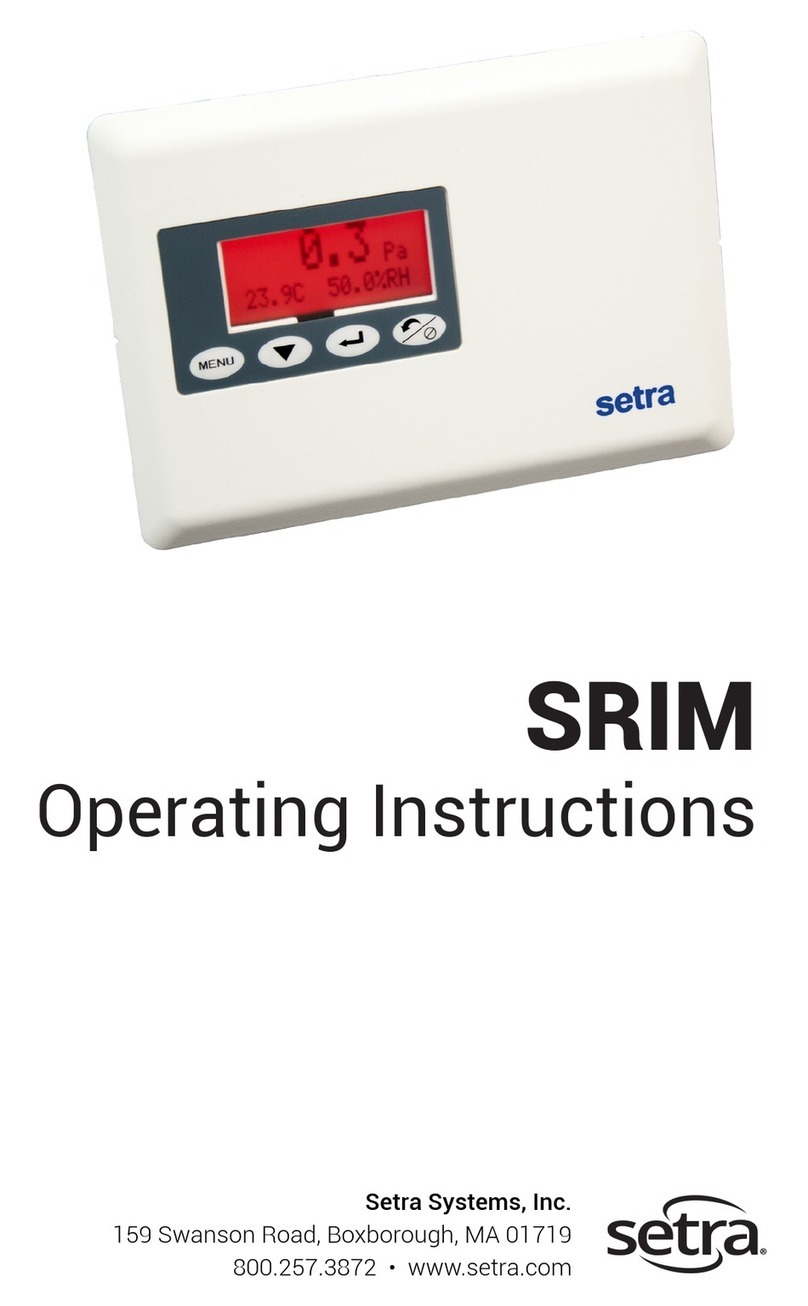
Setra Systems
Setra Systems SRIM1 User manual
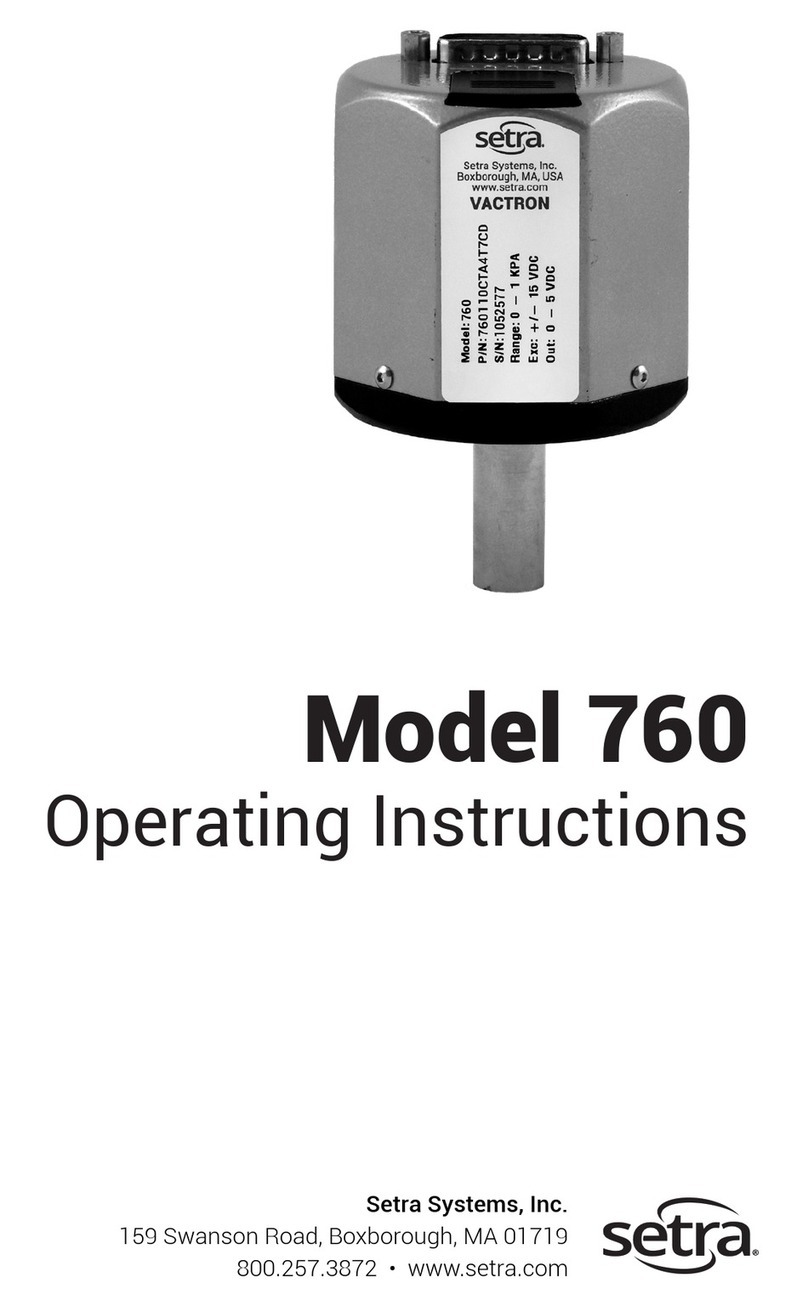
Setra Systems
Setra Systems 760 User manual
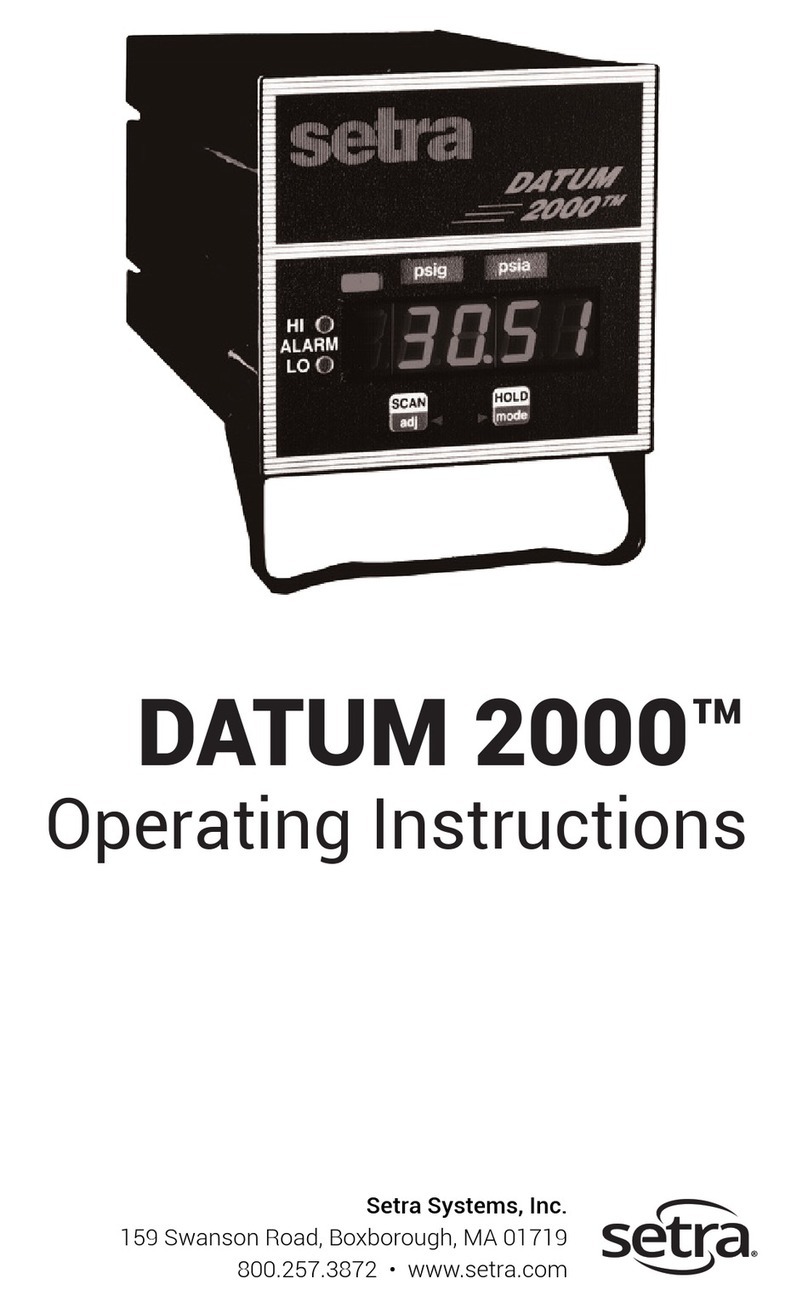
Setra Systems
Setra Systems DATUM 2000 User manual
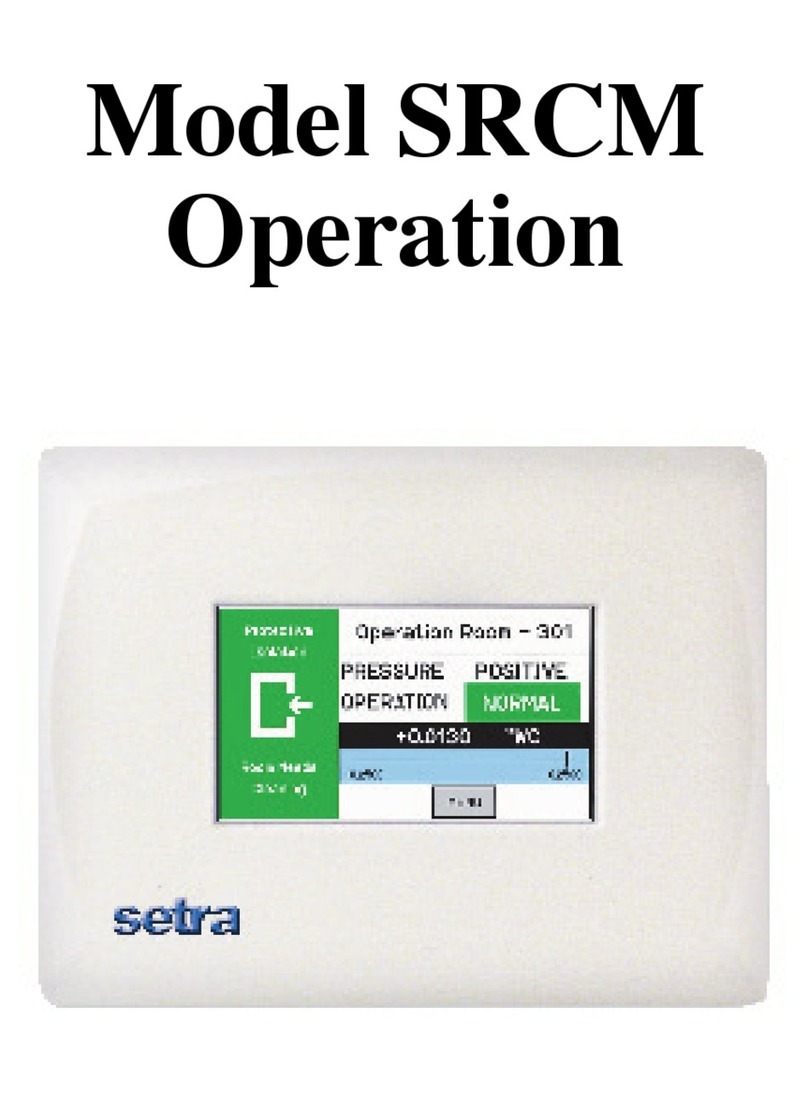
Setra Systems
Setra Systems SRCM Installation manual
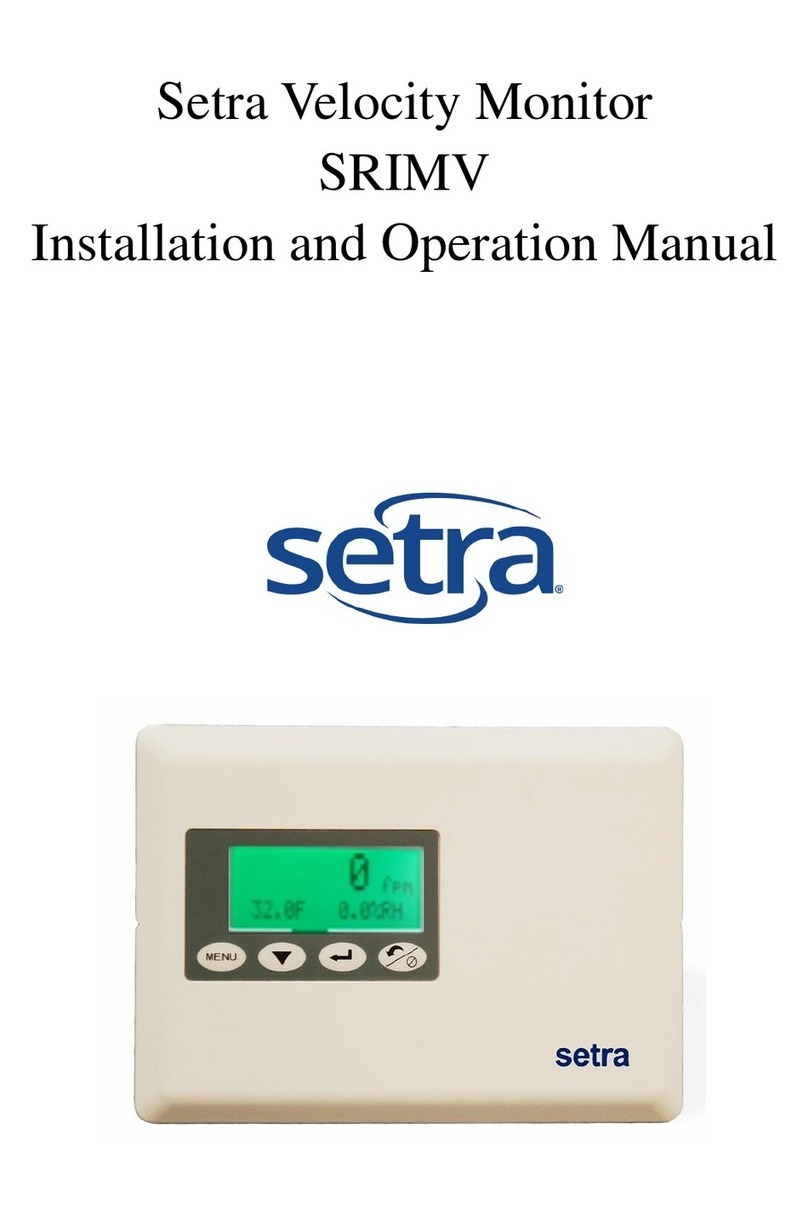
Setra Systems
Setra Systems SRIMV Operating instructions
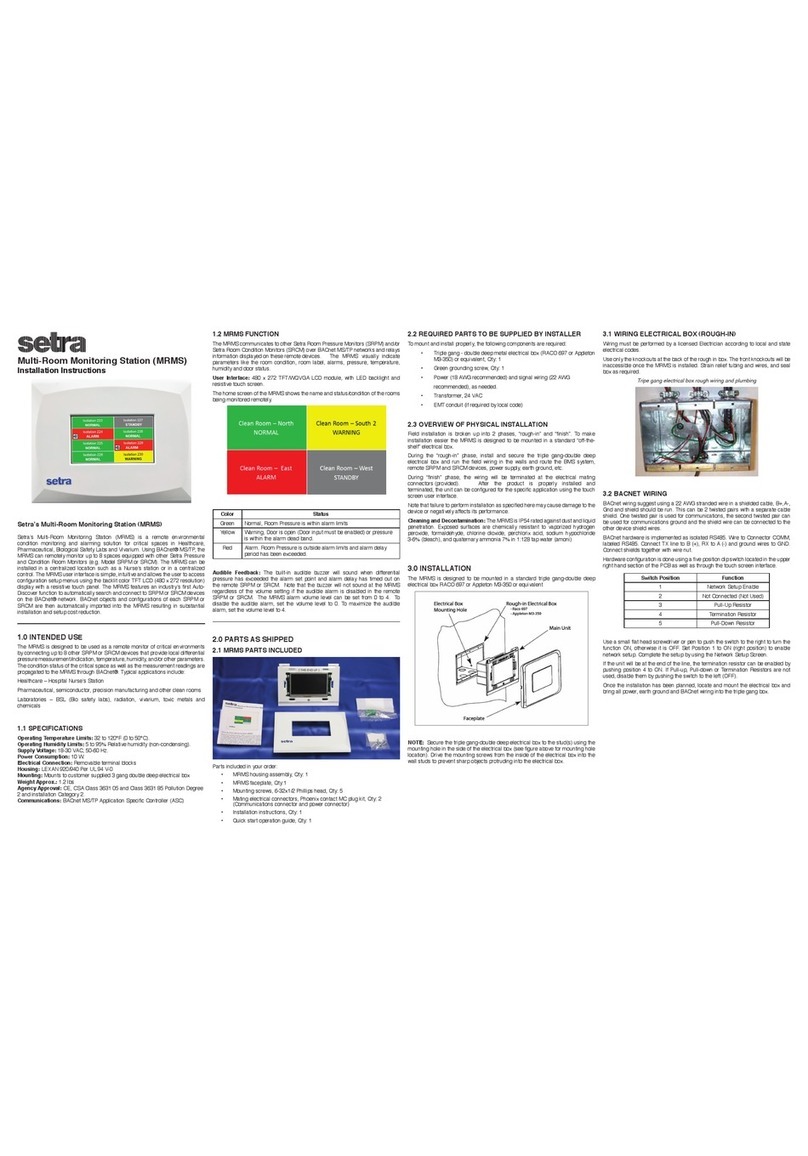
Setra Systems
Setra Systems MRMS User manual
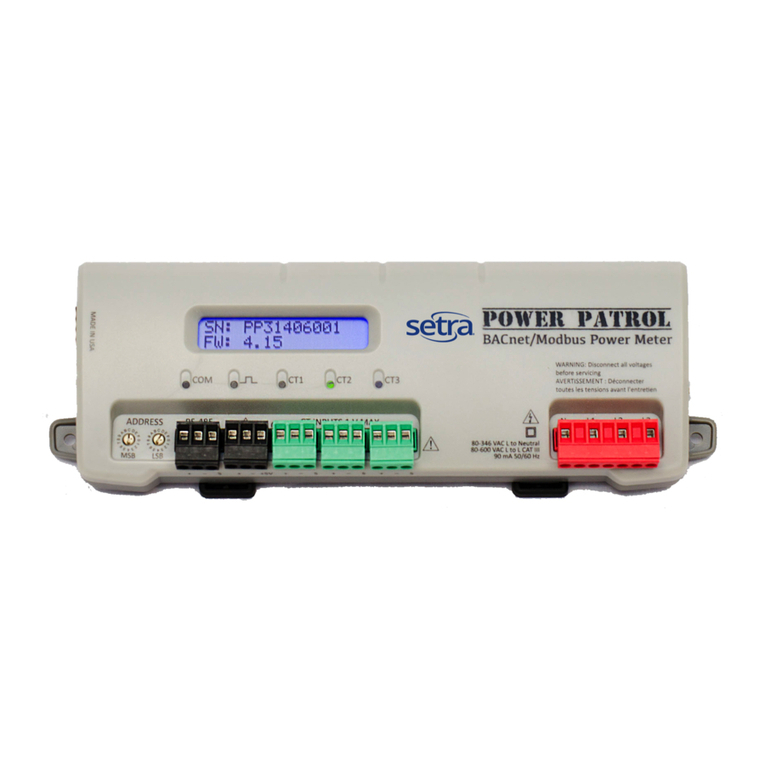
Setra Systems
Setra Systems Power Patrol Manual
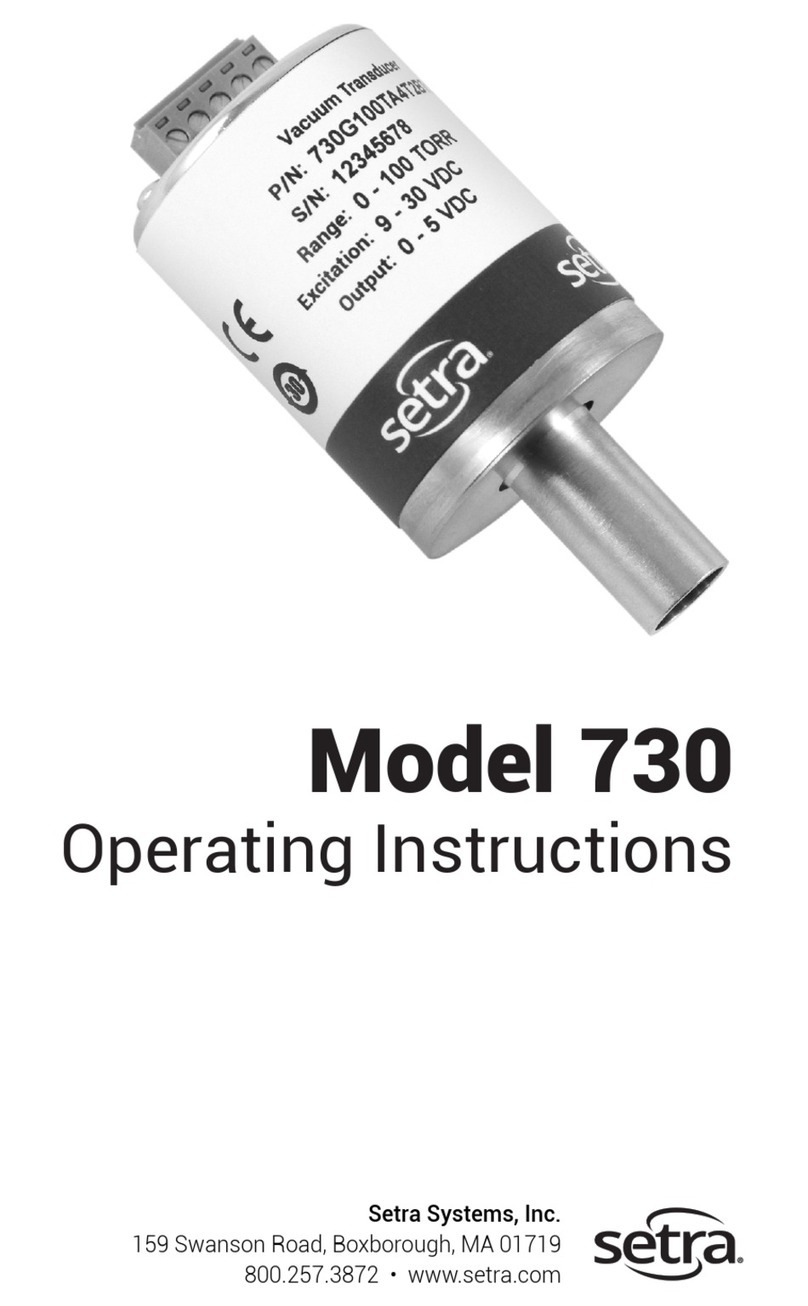
Setra Systems
Setra Systems Model 730 User manual
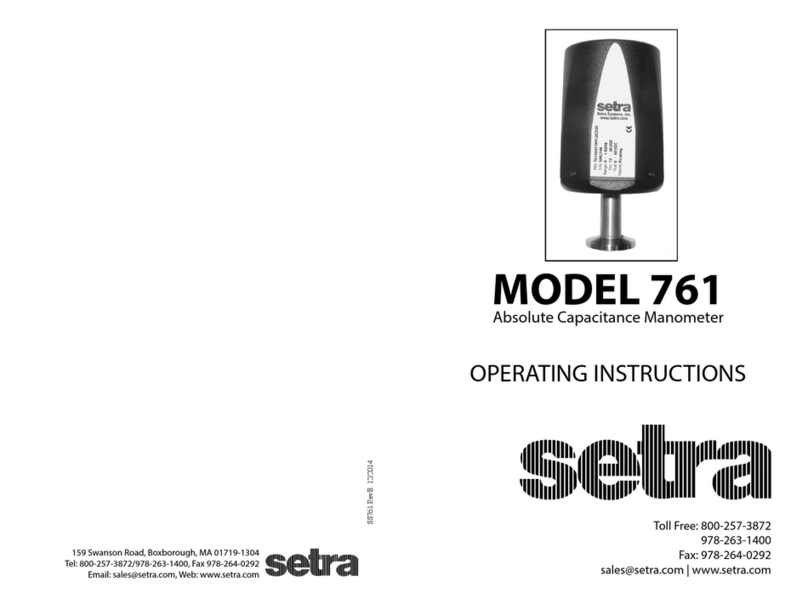
Setra Systems
Setra Systems 761 User manual
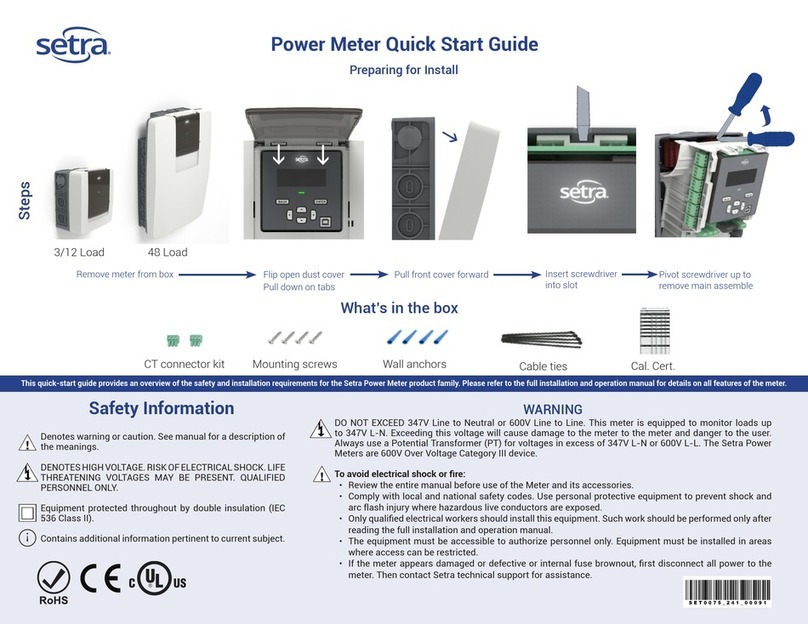
Setra Systems
Setra Systems SS-SPM User manual



